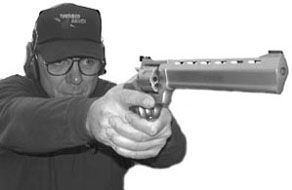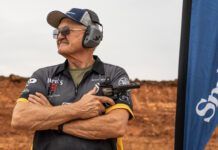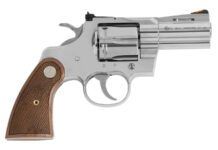
The hunting revolver needs power and long-range accuracy, which it usually gets by topping off long cases with heavy bullets. These big, blunt bullets get their velocity by virtue of big powder charges behind them, but even so, they shoot with more arc than a lot of hunters want. Also, because the shoulder does not support handguns, muzzle flip can make them hard to handle. Even the newest heavyweight revolver cartridges are more efficient at delivering power than they are a flat trajectory.
Perhaps the focus of hunting revolvers doesn’t need to be on delivering long-gun power after all. One solution that some revolver makers are trying is introducing rifle cartridges that deliver a lighter bullet at much faster speeds.
One such revolver is the Raging Bee, chambered in .218 Bee, from Taurus International. Also, Taurus chambers the .30 Carbine in another large gun similar to the Bee, called the Raging Thirty. For its part, Sturm, Ruger & Company makes a .30 Carbine New Model Blackhawk. We wanted to see how comfortable and accurate these wheelguns were to shoot, so we pitted them in a head-to-heat test and found out.
Ruger .30 Carbine New Model Blackhawk BN31, $435
Of late we are seeing new interest in the .30 Carbine military rifles because they have so much history and classic visual appeal. Perhaps adding to this is one virtue seldom pointed out. That is, .30 Carbine has always been produced with non-corrosive components, which is why so many .30 Carbine weapons are still functioning in very good condition. The original intention of this cartridge was to fill the chambers of a compact rifle, giving U.S. servicemen more power than the .45 ACP pistol in situations where a full-sized Garand was impractical. Today, the .30 Carbine finds its niche with a lightweight bullet packed in a straight-walled case, and it’s just right for shooting even big game at 50 yards.
[PDFCAP(1)]At first glance the BN-31 incarnation of the New Model Blackhawk does not tell you that it is chambered in a rifle caliber rather than one of the more popular revolver cartridges. It is not especially long, the barrel is not extra heavy, the frame is not elongated, the cylinder lends no clue and the walnut grips are standard Ruger equipment. The overall look is of a Western-style single-action six-shooter, but the adjustable rear sight reminds you that this is a modern revolver. In handling this single-action-only revolver, you will find there is no loading position for the hammer. The act of swinging open the loading gate allows the cylinder to rotate while activating a safety that makes it impossible to pull the hammer back to a ready-fire position — standard Ruger New Model design.
One feature that distinguishes this model is the tapered barrel. At 7.5 inches the barrel is among the longest in the New Model Blackhawk lineup (Super Blackhawk models are available with 10.5-inch barrels). Though .30 Carbine is a rifle caliber, it is not an especially powerful one that develops a great deal of pressure. Super Blackhawk models chambered for real boomers are built with a heavier frame that extends well forward of the forcing cone. We found the tapered barrel contributed to two characteristics to note.
For one, when reinstalling the cylinder after cleaning you must be sure to mate the relief in the cylinder rod to the curvature of the barrel. As the barrel thins out toward the muzzle, there is enough room to start the cylinder rod with the full-diameter-side facing the barrel. This will lead to jamming against the outside of the barrel as the rod is pushed into the frame. Characteristic two is how the front sight is mounted. Though the front sights on all New Model Blackhawk revolvers are mounted on a stanchion atop the barrel, the tapering means that this stanchion must be larger. Our greatest problem shooting this revolver turned out to be glare from the front sight. Not only do we feel the serrations in the front ramp blade were too fine to do a good job of dispersing glare, but we also think the stanchion below the front sight contributed to the problem by reflecting light itself.
[PDFCAP(2)]That we were able to print groups measuring less than 2 inches at 50 yards (supported) is a testament to how well the rest of this Ruger revolver has been adapted to .30 Carbine. With patience we were able to land some very good five-shot groups. Overall average for all shots fired was 2.4 inches, with a high of 3.1 inches (Federal American Eagle) and a best of 1.8 inches (Winchester USA). The classic bullet weight of 110 grains was standard throughout our tests. Firing standing, we found that shooting with gloves (especially tacky ones like Nike’s Magnigrip football gloves designed to give extra grip to receivers) made it easier to follow through and control muzzle flip inherent in the design of round-backed “cowboy” stocks. Firing offhand was much more fun than the bench work, where muzzle rise was amplified by contact with the sandbag rests.
From the Ruger we observed muzzle energy ranging from 468 to 584 foot-pounds of energy. In this case one could think of the .30 Carbine as a pleasant alternative to a .357 Magnum. With better sights we think this revolver will come much closer to its potential.
Taurus Raging Bee .218 Bee Model 218SS10, $898
With the introduction of the Raging Bee, Taurus International continues to provide the shooting public with something to talk about. Previously, we have reviewed the Raging Bull chambered in the wide-body .454 Casull. In our February 2000 test, we found the Bull, by virtue of its weight and ported barrel, to be the Casull that was easiest to shoot. Since then Taurus has found this same frame had plenty of room and strength to launch rifle caliber rounds as well. Thus, we decided to include it in this rifle-caliber test.
[PDFCAP(3)]The Raging “platform” is capped with an excellent rubber grip with a gentle palm swell and rear strap. While the insert appears in red for the Bull revolver, the smaller rifle-caliber guns sport a yellow insert. The cylinder lockup is double the average revolver. The right-hand thumb must slide the release mounted on the left side of the frame forward, and the opposite thumb must pull down a release mounted ahead of the cylinder located on the crane. This crane lock makes an extra detent typically installed at this point unnecessary. The forward tip of the ejector rod is capped and does not play a part in lockup.
In testing the Raging Hornet in .22 Hornet, we found that its longer barrel with heavy underlug made porting unnecessary to control recoil or muzzle flip. Also, with the same diameter cylinder as the .454 Raging Bull in place, there was room for eight smaller holes. The Raging Bee is virtually the same gun as the eight-shot Raging Hornet, but the cartridges differ noticeably.
On average, muzzle energy lagged behind the Hornet by more than 100 foot-pounds, and the Bee was way down on power compared to the .30 Carbine. Also, finding .218 Bee ammunition was difficult. While we were able to test the Ruger with three different brands of .30 Carbine (albeit all topped with 110-grain bullets) everywhere we shopped wholesale or retail offered only Winchester’s silver-boxed Bee 46-grain hollowpoint. But with little frontal area to catch wind, the advantage of this skinny round is its ability to fly, making it a worthy varmint round. Since we did not use a scope with the Ruger, we elected not to add a scope to the Taurus as well. This was a shame, actually, because we had in hand the Jack Weigand-designed bolt-on scope mount ($54.95 delivered from Taurus) which we used with much success in the Raging Hornet test.
Taurus lists the barrel of the Raging Bee as being 10 inches long, but we measured the crown to be recessed approximately 0.2 inches from the tip. Therefore, we list the gun’s barrel length as 9.8 inches in the accompanying tables. But above this is 11.5 inches of true sight radius. Mixed with a fully adjustable rear sight with plain black face and a simple flat-faced front blade, we had little trouble obtaining a good sight picture even at 50 yards. While we had to work very hard to obtain good shots from the Ruger, we found printing small five-shot groups single-action from a sandbag rest at 50 yards to be no chore at all. Often, we have to spend time getting used to a gun, learning how it responds at point of ignition or how to place the sights and approach the trigger. But we found the Taurus Raging Bee to be most accommodating.
[PDFCAP(4)]Also, by offering double-action fire, the Raging Bee goes one up on the single-action Ruger Blackhawk. Actually, when we tested the Raging Bull and even the Raging Hornet, we did not find the double action to be a source of real speed beyond the ability to skip a step in rotating the cylinder.
But after dry-firing the Raging Bee, we fired at a target 7 yards away, the object of which was to shoot acceptable center-mass groups rapid fire. Using a Competitive Edge Dynamics Model 6000 sound activated timer ($134.50, Brownells, 800-741-0015), we responded to the starting “beep” with two shots as fast as we could pull and release the trigger. With one of our more accomplished revolver shooters “at the wheel,” our five attempts registered splits of 0.26, 0.23, 0.23, 0.24, and 0.24 seconds between shots. Combined with the flash from the cylinder gap and the appearance of this 16-inch long stainless steel revolver with racing car-sized graphics, this performance did draw attention at the public range. The Raging Bee does have charisma.
Taurus Raging Thirty .30 Carbine Model 30CSS10, $898
The Raging Thirty is virtually the same gun as the Raging Bee save for chambering. We could find only two other notable physical differences. The cylinder of the Raging Thirty is approximately 0.02 inch shorter to make room for moonclips. This contributes in part to the gun weighing some 2 ounces less than the Bee. The weight of pressure required to release the single-action trigger was the same (5.2 pounds), but the double-action press was noticeably heavier on the .30 Carbine gun: 14 pounds of pressure, or 3 extra pounds compared to the Raging Bee’s DA trigger.
[PDFCAP(5)]Still, the heavier pull didn’t slow us down much. Pounding out duos of consecutive shots, our split times ranged from 0.23 to 0.29 seconds. The heavier trigger is likely related to the needs of the cartridge for reliable ignition, the physics of moving the heavier cartridge, and whatever incidental manufacturing differences there may be. Certainly no one will be taking this gun to Bianchi Cup, but in the field, double action will allow a follow-up shot without the delay of manually resetting the hammer.
From the bench we enjoyed the same easy sight picture as found on the Raging Bee, and the big underlug common to the Raging series revolvers is ideal for supported shooting. Average group size for all shots fired was 1.6 inches, helped along by our only sub-1-inch group in the test firing the Federal American Eagle 110-grain metal case bullet. This was an outstanding performance considering that in the previous test of the Raging Hornet, our only other sub-1-inch group at a distance of 50 yards was registered when we mounted a scope. Other Raging revolvers we have tested include Raging Bulls in .454 Casull and .44 Magnum. Of the four, the Raging Thirty proved to be the most accurate.
Comparing the Raging Thirty to the .30 Carbine New Model Blackhawk, the Raging Thirty makes best use of the longer barrel to produce more velocity and as a result more energy. The Federal Classic 110-grain Hi-Shok Soft Point Round Nose produced the most muzzle energy (670 foot-pounds). This was an increase of 154 fps above what the Ruger generated. While the barrel shroud is 10 inches, the crown is recessed and again we list it as being 9.8 inches of rifled bore. Actual measurements, however, were 9.83 inches from forcing cone to crown for the Raging Bee and 9.77 inches for the .30 Carbine model.
The only operational difference between the Raging Thirty and the other Raging revolvers is the use of moonclips for the .30 Carbine ammunition. The good thing about moonclips is all the rounds go in and come out at the same time. If a case becomes stuck due to overexpansion or a dirty chamber, the combined leverage of the ejector rod and clip will likely help it eject without a problem. The downside is each time you want to load the gun you need the rounds to be loaded into a clip. The Raging Thirty will ignite rounds without them being held in a clip but we found that pressing the ejector rod would not always eject every single spent case. Last, a moonclip gun is only as good as the quality and condition of its clips. We found that of the five supplied clips, one of them would not securely hold all eight rounds. Sometimes this has to do with the cases themselves. Winchester cases, for example, are generally more solid in a clip than other brands, we have found. While no tool was necessary for loading and unloading the Taurus moonclips, we might trade this convenience for a more secure hold even if it meant having to carry a special “de-mooning” tool. Moonclips are often associated with speed loading, but with eight long .30 Carbine rounds it was more like trying to insert cooked spaghetti. Frankly, we could live with the Raging Thirty with or without moonclips. At worst they are an unnecessary complication. With an MSRP of $898 it might be easy to for the reader to dismiss the Raging Revolvers as being too expensive. But after testing them all we think the Raging Thirty best accomplishes what we perceive as the mission of the Taurus rifle caliber revolver series. That is, a high-capacity, portable, and accurate repeating weapon chambered in a caliber that is effective at handgun distances, is comfortable to shoot and affordable to reload.
Gun Tests Recommends
Ruger .30 Carbine New Model Blackhawk (BN31), $435. Buy It. We would change the sights, but the machinery is here to make this a rewarding shooting experience. We feel .30 Carbine is a pleasant match for the Blackhawk. Likely available for less than $400, the handloader should find this gun to be a bargain.
Taurus Raging Bee Model 218SS10, $898. Conditional Buy. This is a specialty gun that succeeds. The cost of ammunition, however, is prohibitive, and different loads are difficult to find.
Taurus Raging Thirty .30 Carbine Model 30CSS10, $898. Our Pick. You may not want to tote this much gun, but compared to the Ruger, it was much easier to shoot accurately and produced much more power out of the box. We feel this model exemplifies what a modern hunting revolver is all about. Of the Taurus Raging revolvers currently available, we are (for once) not put off by the price.




























